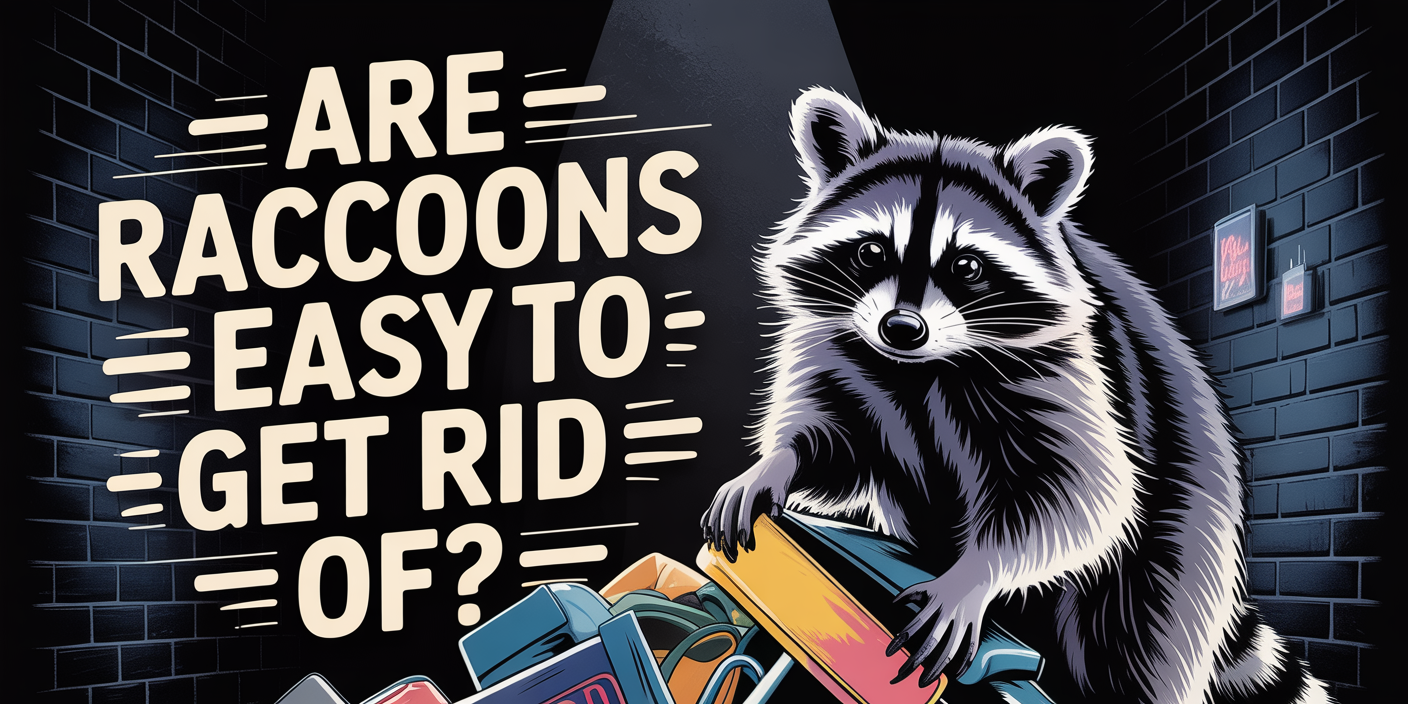Not really. Raccoons are clever, persistent, and often protected by wildlife laws, which makes getting rid of them far more complicated than it sounds. Without the right tools, timing, and expertise, what seems like an “easy fix” quickly turns into a frustrating, messy, and sometimes dangerous problem.
At first glance, raccoons might seem like curious little visitors just passing through your yard. Give it a day, and suddenly they’re scaling your walls, nesting in your attic, and treating your trash like an all-you-can-eat buffet. So—are raccoons easy to get rid of? Not even close.
Most homeowners assume they can chase them off with a flashlight or a few loud noises, but raccoons are smart, stubborn, and surprisingly good at turning your home into theirs. If you don’t act quickly and strategically, a small problem turns into a major (and expensive) one. This guide breaks down what actually works, what doesn’t, and why calling in a pest control pro like AAAC Wildlife Removal might just be the smartest move you make.
How to Spot the Signs and Keep Raccoons Away From Your Home
Raccoons don’t always announce themselves with a dramatic entrance, but the clues they leave behind are hard to miss once you know what to look for. Scratching sounds in the attic at night? That’s not your imagination. These nocturnal freeloaders are most active after sundown, rummaging through insulation, wiring, and whatever else they can tear into.
Look for physical evidence like overturned trash cans, muddy paw prints, droppings near entry points, or damage around soffits, vents, and chimneys. You might also notice torn ducts, chewed wood, or even a distinct, musky odor if they’ve been nesting close to a consistent food source. That smell might be strongest in enclosed areas like the attic or crawl space, where raccoons love to nest undisturbed. In some cases, you’ll catch them in action, boldly roaming your property during daylight hours, which usually signals baby raccoons nearby or a raccoon that’s gotten too comfortable for its own good.
Ignoring these signs means giving raccoons more time to dig in, reproduce, and damage your home from the inside out. If any of these red flags sound familiar, it’s time to act fast before they turn your attic into a long-term vacation rental.
Wildlife Control: How to Get Rid of Raccoons Infestation the Right Way
Getting rid of raccoons isn’t about scaring them off once and hoping they don’t come back. It takes a mix of strategy, timing, and follow-through. Here’s how to handle it the right way—before they do more damage than you can see.
1. Confirm They’re Gone Before Sealing Anything
Don’t trap a raccoon inside, unless you’re ready for the chaos. Before you patch up entry points, you need to make sure no raccoon (or babies) is still inside. Block the wrong hole too soon and you’re in for shredded insulation, chewed wires, puddles of urine, and one furious animal trying to claw its way out. This step is non-negotiable, and it’s one of the biggest mistakes DIYers make.
2. Use One-Way Doors or Humane Traps Legally
This isn’t your average pest problem. Wildlife laws apply. If you’ve confirmed the raccoon has an escape route, you can install a one-way door over their main access point so they can leave but can’t get back in. Trapping is another option, but it must be done using humane, approved methods that meet your state’s regulations. Otherwise, you could face fines or worse.
3. Eliminate What Attracts Them
Trash buffet? Leaky pet food bin? If raccoons find a steady food source nearby, they’ll keep coming back. Secure garbage bins with tight-fitting lids, bring pet food indoors, and remove low-hanging fruit or bird feeders for a while. Raccoons aren’t sentimental—they’ll leave if your home stops being convenient. Make it clear they’re not welcome, and don’t give them a reason to stick around.
4. Seal All Entry Points and Vulnerable Areas
Once they’re out, lock the doors behind them, permanently. Inspect your roofline, vents, soffits, chimneys, crawl spaces, and other vulnerable spots for gaps or weak points. Use galvanized steel mesh or heavy-duty hardware cloth to cover access points. Skip the duct tape and foam filler; raccoons are strong and smart enough to rip through most temporary fixes.
5. Know When to Call the Pros
If they’ve been there more than a day, you’re already behind. The longer raccoons are in your home, the harder it becomes to evict them safely and completely. If you hear movement in the attic, spot droppings, or find signs of a nest, your best move is to call AAAC Wildlife Removal. They’ll handle the removal, cleanup, and exclusion work with professional pest control methods, legally, humanely, and fast.
Prevent Future Visits After You Get Rid of Raccoons
Getting rid of raccoons is only half the battle. To prevent raccoons from returning, you need to remove every reason they had for showing up in the first place. If your home still looks like an open invitation, they—or their equally bold friends, will be back before long. Prevention isn’t about one magic fix, it’s about cutting off every advantage raccoons use to make themselves comfortable.
Start with these proven tactics to keep raccoons off your radar for good:
- Lock down your trash like it’s gold. Use bins with animal-proof lids, and store them inside a garage or shed when possible. Raccoons have clever paws and sharp memory, so one successful snack run means they’ll come back expecting seconds.
- Fix any gaps or damage around your roofline. Raccoons are skilled climbers and will happily exploit loose shingles, uncapped chimneys, or torn soffits to sneak back inside. Metal flashing and sturdy mesh are your best bet for closing those gaps.
- Trim back overhanging trees and vines. Tree branches and ivy that brush against your roof act like raccoon highways. Cut them back at least 6 to 8 feet from the structure to keep access points out of reach.
- Remove easy food and water sources. Bring pet food bowls indoors, clean up fruit that’s fallen from trees, and drain standing water around the yard. These small changes go a long way in making your home less appealing.
- Use motion-activated lights or sprinklers. Raccoons prefer stealth. Surprise lights and sudden bursts of water can make your yard too stressful to visit, especially when paired with other deterrents.
- Install chimney caps and vent covers. These are some of the easiest entry points for raccoons looking to nest. A properly fitted cap or cover blocks access while still allowing proper ventilation.
By locking down your space, you cut off the resources raccoons rely on, and that’s what makes your home a no-go zone. Prevention isn’t glamorous, but it’s the quiet hero that keeps wildlife problems from turning into long-term headaches.
Raccoon Removal Can Be Tough, But You’re Not Alone
Raccoons are clever, persistent, and stronger than they look, which is exactly why getting rid of them isn’t a quick weekend project. Once they’ve found a cozy spot in your attic or shed, it takes more than scare tactics and good intentions to get them out—and keep them out.
The good news? You don’t have to tackle it alone. AAAC Wildlife Removal has the tools, experience, and legal know-how to deal with raccoons the right way—quickly, humanely, and with zero shortcuts. If your home’s been hijacked by a furry intruder, take action before the damage gets worse. One call and you’re on your way back to a raccoon-free home.




